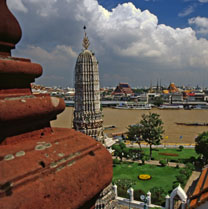|
We
arrived in Bangkok at 2:00 in the morning. The ride we had
previously arranged to our hotel did not show so we took a taxi.
Unfortunately, the streets around our hotel were closed. It seems
that the king's sister had died the previous year and they were
having a parade in her honor the next week. The parade route was
closed for a "practice" parade the following morning.
Unfortunately, the parade route closed streets on three sides of
our hotel with the Chao Phraya River on the fourth. The police manning
the road block said it would be fine for us to walk through the
parade route. So, at 3:00 in the morning in a ginormous foreign
city we took our bags, paid the taxi and began to walk through the
city, stopping at each road block to get directions from the police.
Bangkok addresses are not like other cities. The numbers follow
no particular order, so addresses reference landmarks. Ours, for
instance was 394/27-29 Soi Pansook (near BankThai Tatien Branch).
The police couldn't have been any friendlier. The last one we spoke
to even took our map and got on his bike to locate our hotel for
us. Thai's, I must say are among the friendliest people I have ever
encountered.
Bangkok
started as a small village on the Chao Phraya River. It was made
the capital of Thailand (aka Siam) in 1768. Bangkok is also Thailand's
largest city with a population of over 8,000,000 people, though
roughly 15,000,000 live in the greater Bangkok area. The Chao Phraya
River is still an important part of the city, providing food, water
and transportation. The official ceremonial name for the city is
"Krung-devamahanagara amararatanakosindra mahindrayudhya mahatilakabhava
navaratanarajadhani puriramya utamarajanivesana mahasthana amaravimana
avatarasthitya shakrasdattiya vishnukarmaprasiddhi". Loosely
translated that means The city of angels, the great city, the
eternal jewel city, the impregnable city of God Indra, the grand
capital of the world endowed with nine precious gems, the happy
city, abounding in an enormous Royal Palace that resembles the heavenly
abode where reigns the reincarnated god, a city given by Indra and
built by Vishnukam. The name is in the Guiness Book of World
Records as the longest place name.
Though
it is Thailand's second largest city, Chiang Mai is almost
the polar opposite of Bangkok. With about a million people in its
metropolitan area it is not nearly so dense and it is possible to
escape the noise and the crowds. It is also far cooler and less
humid (though still pretty damp), than the Thai capitol. The name
Chiang Mai means "New City" but the 700 year old city
was founded in 1296. It was the capital of the Lanna Kingdom (Northern
Thailand) until it was overthrown by Burma in the 16th century.
It became part of Siam 1774.
Chiang
Mai is a city of temples. There are literally hundreds and we visited
many while there. It is a beautiful area and the mountains around
the city have temples, hill tribes and even elephants. One of the
high points of the trip was riding Elephants in Chiang Dao and rafting
on the Ping River. Thai hospitality is evident everywhere in Thailand
and tourism (and associated tourist traps) are alive in well in
Chiang Mai. However, the city's relatively small size and the ability
to get outside of the city give you a better feel for Thai culture
than you get Bangkok and Phuket.
Phuket
is located on the Andaman Sea. Originally famous for tin mining,
it is now made for tourists. That being said, it is relaxed, stunningly
beautiful in places and provided some much needed relaxation after
the hectic pace of the Bangkok and Chiang Mai. Unfortunately, rain
finally caught up to us here but we were still able visit the Phi
Phi Islands, eat some Fantastic food and catch some real quality
beach time. We stayed in a lovely hotel on Kata beach. Kata is one
of many communities on Phuket island. Phuket City is the provincial
capital and Patong is where much of the night life and shopping
are located. The Krabi province and Phang Gna Bay, famous for their
stunning scenery, are also located nearby, unfortunately we were
unable to visit....next time.
Nearly
half of Thailand's deaths in the 2004 tsunami were in the area of
the Andaman Sea, including Phuket Island. The area in which we stayed
was hit hard by the tsunami though we saw little evidence of its
destruction, save the "Evacuation Route" signs that are
now placed strategically throughout the area. I believe that many
communities more distant from the tourist centers are still hurting
economically.
|

